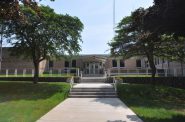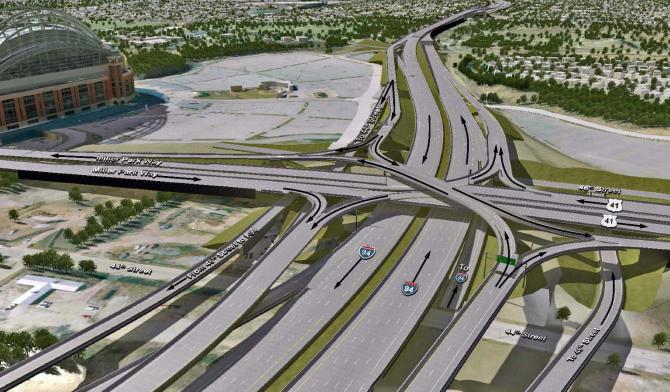I-94 Cancellation Has Huge Impact
Pushing project back decades, adding billions in costs, hurting metro area.
Gov. Scott Walker’s decision to scrap the East-West Milwaukee freeway project has implications far beyond that 3.5-mile segment of highway.
To use the governor’s own words, he has shelved “for the foreseeable future” action on the unavoidable need to rebuild SE Wisconsin freeways.*
This likely means the necessary work will extend into the second half of this century. The eventual cost will be billions higher. In the interim hundreds of millions will be spent on short-term repaving — money siphoned away from maintenance of out-state roads.
According to the authoritative Southeastern Wisconsin Regional Planning Commission, about $12 billion would have been needed over the next three decades to rebuild and modernize sixteen different segments of SE Wisconsin freeways. That schedule and estimated budget estimate are now kaput.
Projects in limbo, in addition to the E-W, include:
- I-43 between Howard and Silver Spring.
- I-43 between Silver Spring and State Highway 60.
- I-894 around the western and southern periphery of Milwaukee.
- I-94 from the Zoo Interchange through Waukesha County.
Complicating the picture are dozens of aging bridges that are integral parts of the freeway network. Their reconstruction normally would have been part of the phased freeway rebuilding. Several of those bridges won’t last that long. They’ll need to be rebuilt in patchwork fashion, with higher costs one result.
When Gov. Walker spoke to a citizens group last year in Ashland he explained that his plan for avoiding a gas tax increase relied on delaying “Milwaukee” projects. He now is implementing that strategy. In doing so he has turned his back on a bipartisan consensus dating to the 1990s on the need to rebuild and modernize Eisenhower-era freeways. While he apparently sees this as furthering his 2018 re-election prospects, it’s a strategy that comes with a high long-term cost.
*The sole exception is the Foxconn-inspired commitment to reconstruct I-94 in Racine County, but just barely: the project’s funding is actually 60 percent funded, with $250 million in new debt accounting for 40 per cent of the spending.
If you think stories like this are important, become a member of Urban Milwaukee and help support real, independent journalism. Plus you get some cool added benefits.
More about the I-94 East-West Expansion
- Transportation: 27th Street Bridge Will Close For A Year - Graham Kilmer - Nov 29th, 2025
- Coalition Raises Concerns on I-94 Construction - Sierra Club - Nov 12th, 2025
- Construction Starting On $1.7 Billion Interstate 94 Widening - Jeramey Jannene - Oct 15th, 2025
- Governor Evers approves first segment of I-94 East-West construction to begin in Milwaukee County - Wisconsin Department of Transportation - Oct 15th, 2025
- Transportation: Fix At Six Coalition Sues State, Federal Government Over I-94 Expansion - Graham Kilmer - Aug 20th, 2024
- WisDOT to host I-94 East-West Freeway Project public meetings - Wisconsin Department of Transportation - Jun 12th, 2024
- Open Houses Announced For I-94 Widening - Jeramey Jannene - Jun 6th, 2024
- ‘Fix at Six’ Group Wants I-94 Expansion Delayed For Civil Rights Report - Jeramey Jannene - Mar 20th, 2024
- Coalition Admonishes I-94 expansion Record of Decision - Sierra Club - Mar 20th, 2024
- Feds Approve Interstate 94 Expansion - Jeramey Jannene - Mar 8th, 2024
Read more about I-94 East-West Expansion here
The Contrarian
-
Parents May ‘Break Up’ MPS
 Feb 8th, 2022 by George Mitchell
Feb 8th, 2022 by George Mitchell
-
School Choice Key Issue in Governor Race
 Sep 1st, 2021 by George Mitchell
Sep 1st, 2021 by George Mitchell
-
Jill Underly Flunks School Choice 101
 Feb 22nd, 2021 by George Mitchell
Feb 22nd, 2021 by George Mitchell
Transportation
-
Congestion Pricing Cuts Air Pollution in New York City
 Dec 14th, 2025 by Jeff Wood
Dec 14th, 2025 by Jeff Wood
-
FTA Tells Milwaukee to Crack Down on Fare Evasion — Even Where Fares Don’t Exist
 Dec 12th, 2025 by Graham Kilmer
Dec 12th, 2025 by Graham Kilmer
-
Will GOGO’s Bus Service Ever Get Going?
 Dec 9th, 2025 by Jeramey Jannene
Dec 9th, 2025 by Jeramey Jannene





















Gov Walker is demonstrating a real lack of leadership on this issue. He’s simply trying to make life difficult for Waukesha Republicans so they come to the table with a funding plan. Gov Walker doesn’t want to be the one that raises taxes so he’ll make them do it. Our fearless leader.
You reveal your bias by starting with factual cost increases due to delay but then pivot all concern to the starving of out-state roads.
Maybe it’s somehow for the better though … the new Marquette and Zoo move cars oh so much faster towards the Stadium and all it’s problems that it will probably change voter sentiment. I’m already pissed that $500m (crude project total divided by two for E-W and N-S) of the Zoo has essentially been wasted by moving the bottleneck eastward
Maybe not being able to do a mega project will force the DOT to improve things incrementally with thing like an aux lane between 68th and Hawley after those aging bridges are rebuilt on their own schedule. Do we still lose the economy of scale of the mega project? Maybe, but there’s progress instead of gridlock, literally and figuratively.
This is asinine. Just as Wisconsin is trying to land major corporate citizens, such as Foxconn and Amazon, it blows off constructing the infrastructure for those businesses. The highways and the mass transit. Both are needed. The airport so far is getting done, at least, but the other parts are even more vital.
Weak and cowardly. There are ways to do what needs to be done without making the city and the state bad for business. What good are lower taxes if getting around is worse?
For some of us this action by Walker, no matter what his intentions, is the first thing he’s done, about transportation, that is for good. The sometimes delays that the DOT and Freeway fans talk about are situational and rare. The decrease in travel time, projected by this project was always less than five minutes,
Why should we spend billions to do what every freeway expansion does? It would cause horrible delays during construction and then relief for a short period of time. After that, the freeway would naturally attract more users and clog up at peak usage periods causing another outcry for expansion. When cars are the only answer to moving people around urban areas than this cycle of madness is going to continue.
All of these comments ignore the little known fact that the DOT’s own studies showed that the project would not achieve its goal of reducing rush hour congestion unless regional public transit service was doubled. The trend in recent years has been for transit services and state funding for transit services to be reduced, and there is no real likelihood that funding will be provided by the state anytime soon to dramatically increase transit services. As a result, even the few minutes of travel time savings hoped for from the project weren’t likely to be achieved. If anyone is looking for a billion dollar boondoggle, this was it.
Walker never has done what he says he going to do. PERIOD. 2011 Walker said roads were he’s number one priority. Period. To move commerce, manufacturing and agriculture throughout our state. Alot of counties up north now can barely fix a couple pot holes a year let alone paving their roads. Many are talking about going back to gravel roads because cuts have been so severe. This will be put on future generations to have to deal with. Shame on us to vote people like Walker in office. It’s just smoking mirrors for him.
To have spent $1Billion dollars on a small stretch of road would have been a colossal waste of money. Let’s re-evaluate how DOT came to recommend this solution.
Can someone please explain why we need the Stadium Interchange? State Highway 175/Miller Park Way segment going North/South from I-94 is short and should be reduced from interstate standards. I wrote our local State representatives urging them to convert Highway 175/Miller Park Way into a parkway similar to 794 with 2 lanes north/south bound. I was told this is not feasible due to “differing terrain and topography”.
@Jeffery Jordan, thanks for not being on the road when I am; the lack of your car makes traffic more bearable for the rest of us. “Rush hour” is of course the worst, but it is less about the “five minutes” than it is about the safety — the flow routinely goes from ~60 to dead stop at the Stadium in both directions due to outdated and unsafe designs causing merging and exiting traffic on both sides of the highway. These above mentioned problems are also by no means “situational”, though Brewers games and major downtown events of course do exacerbate the problems.
@Dennis, please cite your source. I highly doubt the that WI DOT recommended transit infrastructure as any part of a solution…the official state stance for decades has been that transit is a local problem, meaning they wouldn’t touch it, don’t plan for it and thus couldn’t factor it in to their planning. Maybe, SEWRPC said this because they look at the larger picture, but even they still say that the 1950s era designed roads are past their prime and need to be redesigned and expanded simply to meet current demand.
@Eric, start here: http://wisconsindot.gov/Pages/projects/by-region/se/94stadiumint/default.aspx The ROD, EIS, and supplementary materials should walk you through how they got to where they did, including backing down from some of the most gold-plated (read: double-deck) alternatives.
@Kevin, the preferred alternative (follow link above) already accounts for an effective downgrading of Hwy 175 by switching from free-flow ramps in all directions to signalized intersections controlling 175 to 94 onramps (the 94 to 175 ramps are left as-is so as to not impede mainline flow. To further reduce 175 to a different form of pavement that looks less like a freeway would simply be eye candy following the change mentioned above.
The E-W must be rebuilt. The only issue is when that will occur and under what alignment of lanes, off-ramps, etc. Rebuilding the road in its current alignment with no expansion or modernization will likely cost more than $500 million I don’t have a precise number but it is available as part of the $20 million in studies that have been spent on this project.
What will happen in the interim, now that Walker has scrapped the project, is a short-term repaving that will last a few years.That will costs tens of millions. It’s like re-roofing a house you know you will be tearing down.
A similar short-term repaving will begin next year on I-894. It is estimated to cost $40 million.
Bottom line: these freeways are at the end of their useful life….temporary repaving lasts a few years and simply puts off (and increases) the eventual, unavoidable cost of reconstruction.
When Ike said “beware the military-industrial complex” he should have added AND the automobile and oil industries.” These last two, coupled with the Interstate systems have encouraged and dictated TERRIBLE land use policies throughout much of the US. Now cities are ringed by highways and bridges they cannot maintain, and foolish Americans are wedded to cars that command their every move. Shame on US.
Dollars for roads are good money after bad. I remember the Weekly Reader papers we got in elementary school in the 1950’s. The interstate system was to improve national defense – the Reds were a threat then, you know – was the story.
Just in the past year I have learned of another reason to build these roads. Escape to the suburbs. Escape the Black and other minorities. Reggie Jackson of Milwaukee’s Black Holocaust Museum tells the background of that story. William J. Barber II tells it in North Carolina and nationally in “The Third Reconstruction.” We have local witness to this in the building and demise of the Park East expressway. That expressway was designed to steam roll through the Black business district. “Progress” was stopped by Sherman Park residents objecting to the destruction of their mixed race neighborhood. But that was too late for the Black Business District. Ruben Harpole explained that story to MPS teachers in the early 90’s.
So what is the just and right thing to do? Own up to the racism of these “road” decisions and address the need for mass transportation that we have been hiding under concrete all these years. Why is there no fast rail transportation from Milwaukee to Madison. Just think who might travel more easily to Madison from Milwaukee. Got the answer? Let’s start doing justice.
i think it’s a good thing. It’s not our obligation to build billion dollar roads to save a few thousand commuters a few minutes per day. If a commute stinks, it’s a good signal to move. there’s plenty of lots available in Milwaukee only a couple miles from downtown.
We’ve spent too much time going deep into debt under the premise that people can live anywhere they want and by right have 70 mph commutes to work. Time to tap the brakes on that failed policy.
Rich, actually the DOT did answer the question of transit capacity to reduce the need to expand the highway. Their plan is in the DEIS (Draft Environmental Impact Statement). On page 96 DOT put relevant transit usage at 700 riders and stated that a capacity of 2000 or so would be required to make the expansion of I-94 unnecessary. In fact, capacity (not usage) already exceeds 9000 in a system that is undermanaged, and underfunded. Instead of addressing management techniques (low cost fares, higher cost downtown parking, rail) to move large numbers on transit, they chose to spend top dollar on concrete.
DOT brushed off criticism of not getting involved in managing transit (a “local” jurisdiction). While they may not have a mandate, they do have a knack for presentations, a bully pulpit, the ear of State government, dollar-watching legislators to guide them, and honest traffic projections – all ready to be aligned with huge savings.
With 8 lanes, traffic latency will pour from the grid into wider, faster roads and generate another generation of daily congestion. Widening alone is a pointless, expensive waste with health and environmental concerns brushed off by DOT.
Yes, contrary to popular belief DOT did analyze and price a bottom-up repair of the 6 lane roadway we have now. $400 million for the disputed stretch. Hopefully they will now spend that money and fix the freeway for the next five future decades. Cities and County governments have stated their commitment to spending less on freeways and are ready to plan a transportation system that works for Milwaukee and SE Wisconsin.
From the EIS re transit:
About 700 people use transit in the I-94 corridor in the morning and afternoon peak hour based on data
from transit providers in early 2013. Almost all are traveling east in the morning and west in the afternoon
because express bus service is set up to serve these trips. If increased transit ridership alone18 were to avoid
the need to add a lane to I-94, transit ridership on eastbound I-94 in the morning rush hour and westbound
I-94 in the afternoon rush hour would need to increase about three-fold, to between 2,000 trips (eastbound)
and 2,200 trips (westbound), to avoid the need to add capacity (one freeway lane can carry a maximum of
2,000 to 2,100 vehicles in an hour).
With the traffic split on I-94 near 50/50, the increase in transit ridership would need to occur not only
among people commuting to downtown in the morning and leaving downtown in the afternoon. There
would have to be a similar number of transit users among reverse commuters traveling west in the morning
and east in the afternoon. Transit ridership on eastbound I-94 in the afternoon peak hour would need to
increase from almost none today to about 2,000 trips in the peak hour. Currently, there is little to no
eastbound transit service on I-94 in the afternoon peak hour; however, the regional transportation plan
recommends establishing reverse commute express bus service. Considering that the traditional eastbound
morning and westbound afternoon commute serves 700 riders in the peak hour, it is unlikely that express
bus transit service for the harder-to-serve reverse commute could attract 2,000 riders in the peak hour.
Thanks, George. I’m glad you posted what appears to me to be a quote from the DOT’s DEIS. Their estimate of required capacity (2000) is far less than actual capacity today (3000 to 9000). The problem is funding the management of transit, and using TDS to induce motorists to ride transit. It is not wishful thinking; it is about planning and spending priorities.
Let’s also remember that SEWRPC, with Walker’s support when Milwaukee County Executive, not only scripted the SE freeway expansion plan but advocated for it by letter to the Governor – – all without recommending a financial plan to fund the work. Now the piper cannot be paid.
Below is what SEWRPC (appropriately) said about funding, which is the job of elected officials. Those officials have not delivered.
“When the WisDOT prepares for the reconstruction of the freeway system on a segment-by-segment
basis through preliminary engineering and environmental impact assessment studies, it is
recommended that the WisDOT also develop financing plans. The financing plans should identify the
expected funding requirements and the expected funding sources for each freeway reconstruction
project, with such plans to be submitted to the Governor and State Legislature for their consideration
along with other required project documentation including preliminary engineering and
environmental impact assessment studies.”